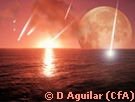Thursday, September 14, 2006
Astronomers Reveal First Alien I.D. Chart (Harvard-Smithsonian)

Washington, DC - It is only a matter of time before astronomers find an Earth-sized planet orbiting a distant star. When they do, the first questions people will ask are: Is it habitable? And even more importantly, is there life present on it already? For clues to the answers, scientists are looking to their home planet, Earth.
Astronomers Lisa Kaltenegger (homepage) of the Harvard-Smithsonian Center for Astrophysics (CfA) and Wesley Traub of NASA's Jet Propulsion Laboratory and CfA, propose using Earth's atmospheric history to understand other planets.
'Good planets are hard to find,' said Kaltenegger. 'Our work provides the signposts astronomers will look for when examining truly Earth-like worlds.'
Geologic records show that Earth's atmosphere has changed dramatically during the past 4.5 billion years, in part because of life forms developing on our planet. Mapping what gases comprised Earth's atmosphere during its history, Kaltenegger and Traub propose that by looking for similar atmospheric compositions on other worlds, scientists will be able to determine if that planet has life on it, and if so, that life's evolutionary stage. [Evolution News, Alien I.D. Chart]
--
From the Harvard-Smithsonian Center for Astrophysics and based on "Spectral Evolution of an Earth-Like Planet": Abstract | Full Text (pdf).
technorati tags: washington, dc, astronomers, earth, planet, star, habitable, life, harvard, smithsonian, center, astrophysics, nasa, jet, propulsion, laboratory, cfa, history, atmosphere, forms, gases, evolutionary, stage, evolution, news, alien, I.D., chart
Add to: CiteUlike | Connotea | Del.icio.us | Digg | Furl | Newsvine | Reddit | Yahoo